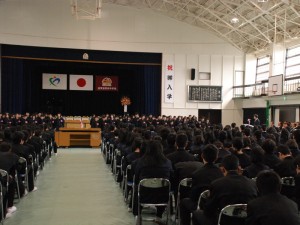curriculum expectations high school language courses Language learning public policy teaching
by sendaiben
5 comments
If I ruled the world… high school English in Japan
This is the third of four posts on reforming English education in Japan. You can see my thoughts on elementary school here, and on junior high school here.
High school is a crucial step within Japan’s English educational system. It is the gateway to university, and currently has the most powerful external incentives for students. Get into the right high school, and you’ll have a shot at a good university. Graduate from a good university (and let’s face it, once you get in it’s not very difficult to graduate) and you’ll be set for life.
That’s how the script used to go. It’s shifting now, which is why we are seeing change on the horizon. Here is my take on high school English education in Japan.
The Current Situation
Most students attend junior high school then go to a separate senior high school. Entry is competitive, and students take the high school test or take advantage of a parallel ‘recommendation’ system (suisen). The system is designed to select candidates based on academic achievement and potential.
Once in high school, students focus on preparing for university entrance tests (if they attend an academic-track high school) or on getting vocational qualifications (if they attend a vocational high school).
From this month all high school English classes are supposed to be taught in English (something that was also part of the 2003 Course of Study but was not successfully implemented) but we will have to wait and see how widespread this turns out to be in practice.
My Thoughts on the Current System
High schools have a lot going for them. They select students based on academic ability. High school teachers are better qualified than junior high school teachers (see MEXT figures for English teachers here). Students are more mature and more conscious of their goals -sometimes 😉
Ironically, English classes at vocational schools are often more practical than classes at academic schools. Freed from the pressure of cramming huge amounts of vocabulary/grammar for the university tests, teachers are free to work at the students’ level and have them work on their communicative competence. Sadly many teachers instead do an ‘academic lite’ class, reviewing junior high school vocabulary/grammar.
The falling number of children due to demographic change is putting a lot of pressure on high schools. The best public and private schools still have students competing to get in, but other schools are becoming less able to select as they only get as many applicants (or fewer) as they have places.
The governments plan to use TOEFL to screen applicants to university (which I disagree with) also has the potential to shake up SHS education.
My Recommendations
These are the things I would most like to see changed in high school English education (many are similar to my requests for junior high school):
- Increase English input for students
This has three parts: teach students why input is important and how they can access it, expect students to do a certain amount of input-based self-study per week, and monitor their progress. Done well, this can have a significant effect on practical English ability, as well as helping students become independent learners. This should include extensive reading with graded readers, as well as online listening and watching videos.
- Increase meaningful English output from students
Students should be speaking and writing ‘real’ content regularly. Writing their reactions or ideas, giving speeches, and having discussions about topics of interest will help them build up their language proficiency. - Introduce content-based lessons
Give students the opportunity to interact with news and current issues through English. This can include reading online, simplifying news stories for the classroom, and using contemporary stories as the basis for output activities as described above. - Create meaningful English qualifications
I would like to see the government create meaningful English qualifications that students could take to demonstrate their ability. At the moment, the STEP Eiken, the TOEIC, and to a limited extent the TOEFL tests fulfil this role at the moment, but they don’t do a very good job of measuring overall English proficiency, particularly with regards to speaking and writing. Perhaps some kind of language portfolio would be the best way of achieving this. The qualifications would ideally be recognised by universities and employers, and provide incentives for students to work on developing actual English skills. - Provide online courses
Based on best practice worldwide (see the Khan Academy or online university courses for examples) create online content using the best teachers. By flipping the classroom in this way, students can use class time for practice and interaction, and learn concepts for homework, in an environment where they can repeat or rewind as much as they need. This would have the welcome side-effect of reducing the importance of cram schools for university entrance. It would also reduce the influence of unqualified or unskilled teachers (only 50% of senior high school teachers hold intermediate English qualifications).
I struggled writing this one. By the time students get to high school, they’ve already had five years of English at school. Any problems have been compounded and it is unlikely that high school alone will revolutionise their experience. For the same reason, changes here will probably have less effect than they would do in elementary school or junior high school.
Still, the fact that students are academically streamed should make it easier for teachers to deliver content appropriate to most of their charges.
Many young people I speak to were profoundly disappointed when they started high school and found that the classes were a continuation of what they had been doing in junior high school. They had honestly been expecting to have things step up a notch and become more challenging/practical.
What do you think? Is senior high school English a lost cause? What practical steps could we take to improve English classes?
curriculum expectations junior high school language courses public policy
by sendaiben
14 comments
If I ruled the world… junior high school English in Japan
This is the second of four posts on how I would improve English education in Japan. Today I am going to be looking at English in junior high school. You can see my thoughts on elementary school English here.
The Current Situation
Junior high school is where serious English study begins. The course of study starts off reasonable (most students can use the English they learn in the first year) but by the middle of the second year the learning curve is too great and it becomes an academic exercise instead of learning to use the language. Many teachers just go through the textbook page by page, with the occasional activity or worksheet thrown in for variety. Classes are large (35-40 students) and passive: students listen to explanations and take notes a lot of the time.
My Thoughts on the Current System
Junior high school English has a bad reputation in Japan. Some of the problems at elementary school (particularly the guidelines against teaching reading and writing) are a direct result of MEXT trying to make sure that classes there are not in the same style as JHS English. Some of this is structural (the large classes, the high school entrance tests) and some situational (overworked teachers and unimaginative materials). Many students start off excited to be learning English, but by the end of the second year the increasingly difficult classes mean that a large number of them are lost and frustrated.
My Recommendations
I want to focus on specific measures that could be implemented fairly easily. Here is my list:
- Improve teacher training
Many teachers at junior high school mean well but did not receive sufficient training pre-service and are not incentivised to pursue further training after they start working. There is a real need for both incentives and opportunities for teachers to develop their teaching skills and their language skills. This should include local training within schools and local areas and internationally, with some teachers being sent on teacher training and language courses abroad. These teachers should then become trainers to spread the new knowledge within their school and local areas. - Hugely increase understandable input
At the moment junior high school students get very little English input (often just their textbooks and the odd handout). Introducing extensive reading and listening, both on- and off-line, would make a big difference to students’ skills and motivation. Students should be listening for meaning from the first grade, and reading for meaning from the middle of the first grade. A large amount of comprehensible input would allow students to use the words and grammar they study, and cement their knowledge of them. Graded readers and online listening (accessible through mobile phones or computers) would not cost very much compared to the potential benefits. - Have students work on productive skills
Students also need to produce language, both spoken and written. Currently students have few chances to speak, and even fewer to write. If students have a chance to try to produce personalised language they are much more likely to be able to use it later. Students should be producing short dialogues, presentations, and writing assignments regularly. - Teach students how to learn
Most students do not know how to learn a language, and few schools specifically instruct them on this key aspect. At the start of English classes, and regularly throughout the three years, students should have the chance to learn about and practice key language learning skills, such as how to use a dictionary, how to learn vocabulary using flashcards, how to learn vocabulary in context, how to find English content online, etc. - Reduce class sizes
With the falling population many schools are finding they have extra classrooms and teachers. Instead of merging schools and closing them, the government should seize this chance to reduce class sizes from the current standard of 40 to something more in line with the rest of the OECD: 20-30 students per class.
What do you think? Would the five suggestions above be enough to improve English education in junior high school? Have I overlooked anything?
curriculum ES expectations language courses public policy teaching
by sendaiben
14 comments
If I ruled the world… elementary school English in Japan
This is the first instalment of my master plan to improve English education in Japan. I’m going to start with elementary school (I don’t have anything concrete to say about pre-elementary school education, especially given how fragmented and individualised it is) today, with junior high school, senior high school, and university following later in the week.
The Current Situation
My impression of what is going on in elementary school at the moment: English is taught in elementary schools for 30 hours each in the 5th and 6th grades. It is not a subject, but rather part of general studies. The purpose of the classes is not to acquire English per se, but rather to get exposure to language learning and international issues in a light-hearted and fun way. Classes are taught by homeroom teachers and visiting assistant language teachers (both native and non-native speakers of English). The current guidelines state that reading and writing should not be introduced. There is little training for elementary school teachers, and the curriculum is limited to the official textbook series Hi Friends.
My Thoughts on the Current System
I was cautiously optimistic about English classes being rolled out across all elementary schools. I used to work in an elementary school that was a test case for the city -all students had English once a week and the school had a specialist teacher who only taught English as well as a full-time ALT (me)- and I thought maybe the government would implement something like that.
Instead it has been a bit of a waste. The goals are unclear and vague, there has not been anywhere near enough training (I have done training for elementary school teachers, and it was discouraging to see how stressed and scared they were about conducting English classes), the content of the classes doesn’t match the students’ developmental levels, and there is little to link the elementary school and junior high school curriculums.
I still believe it could be very beneficial for students to start English earlier than junior high school, but it has to be done properly. If not, it might not be worth doing at all.
My Recommendations
I would like to make several suggestions as to what the government could do to improve English education in elementary schools. I have tried to make them as specific and concrete as possible.
- Assign an English specialist teacher to each school
This teacher would be responsible for leading English classes alongside the homeroom teacher. The teacher could be an elementary school teacher or an ALT. This would take a lot of pressure off regular homeroom teachers, as well as allowing English specialists to develop their expertise. - Implement English throughout elementary school
I would recommend five minutes per day for first and second graders, based around songs and short chants. Third and fourth graders could learn vocabulary thematically and practice simple phrases, again in daily short sessions. Fifth and sixth graders would learn basic phonics. - Link the elementary and junior high school curricula
Students can do a quick review in the first weeks of junior high school before continuing to build upon what they have already done. By covering basic phonics as well as learning vocabulary in elementary school, students could concentrate on learning how to use the language in junior high school.
I think the three proposals above would be a good beginning for making English instruction in elementary schools more effective. Any thoughts? What would you add or take away from that list?


